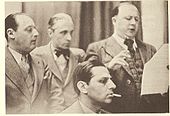Pierre Vellones

Pierre Vellones , pseudonym of Pierre Édouard Léon Rousseau , (born March 29, 1889 in Paris , † July 17, 1939 in Paris) was a French composer .
Life
Pierre Rousseau was the son of a doctor. He had his first musical training with Jean-Hugues Louvier, a friend of Charles-Marie Widor . From 1907 he published his first compositions, a slow waltz for piano, a string quartet and songs. Rousseau, who also had a talent as a watercolor painter, studied medicine and was drafted as an assistant doctor in World War I , where he was also deployed in the village of Velosnes and used this name from his pseudonym Vellones when he published compositions.
In 1926 he was diagnosed with Kahler's disease , so that he had to give up his practice. He specialized in the field of electrotherapy . His patients included Paul Valéry , Gabriel Pierné and Louis II of Monaco .
In his compositional work he was looking for new ways and sounds and was interested in the research of Alexander Mossolow and John Cage . In 1934 he wrote a concert with the saxophone as a solo instrument. He experimented with percussion from Africa and the sound spectrum of East Asia. He was the first musician in France to include the instrument Ondes Martenot in his compositions in 1929 . For Marcel Ichac's documentary Karakoram about the French Himalayan expedition in 1936 he wrote seven Ondes Martenot, piano and traditional drums for the film music . For a composition commission for the Paris World Exhibition in 1937 , he used instruments from the Musée d'Ethnographie .
Vellones wrote the novel Le Pré aux loups (manuscript) and published an essay on Tibetan art.
Compositions (selection)
- Orchestral music
- Au Pays du Tendre
- Concerto en fa pour saxophone and orchestra
- Le Roi Salomon pour soliste, chœur et orchester
- Rastelli pour quatuor de saxophones and orchestra
- Suite cavalière (5 pièces)
- Prelude et danse indienne
- Ballade for piano and orchestra
- Castillanes
- Wind instruments and string instruments
- Trio pour flûte, harpe et hautbois ou alto
- Impressions d'Espagne pour harpe, flûte et basson (2 pieces)
- Théatre des marionnettes pour quintet à vent et piano (3 pieces)
- A Versailles pour quintet à vent et piano
- Images Péruviennes pour flûte et piano
- saxophone
- Rapsodie pour saxophone alto, harp et celesta: op.92
- Au jardin des bêtes sauvages: 16 pieces enfantines pour piano, faciles et progressives
- Cavaliers andalous; pour quatuor de saxophones
- Prelude et rondo français: pour quatuor de saxophones
- Valse chromatique, pour quatuor de saxophones
- Sévillanes pour quatuor de saxophones and percussions
- Rapsodie, pour saxophone alto, avec, accompagnement de harpe, célesta et batterie
- Concerto pour saxophone alto and orchestra. [Op. 65]
- piano
- Ballade for 2 pianos
- Toccata
- Valse Chromatique
- Impressions d'Espagne (2 pièces)
- Planisphère: 8 pieces pour piano
- Vocal music
- Le Cantique des Cantiques pour soprano, ténor, basse chantante, flûte et basson
- Elégie (A. Samain) pour voix moyenne et piano or quatuor à cordes et flûte et harpe or orchestra
- Cinq Poèmes de Mallarmé pour voix moyenne et 4 harpes, 2 saxophones, contrebasse (ou quatuor à cordes, ou piano, ou orchestra)
- Prelude et Cinq Fables de Florian pour voix élevée et piano or jazz symphonique, or orchestra
- Cinq Chansons d'Amour de la Vieille Chine pour voix élevée et piano or flûte, battery et piano
- Cinq Épitaphes (textes anciens, humoristiques) pour voix moyenne et piano (ou orchester)
- John Shag (AG de Voisin) pour voix élevée et 2 pianos (ou orchester)
- A Mon Fils (C. Fontaine) pour voix moyenne et piano (or orchester)
- Le Petit Village (P. Lorys) pour voix moyenne et piano (or orchester)
- Trois Poèmes de Rimbaud pour voix moyenne et piano
- Deux Poèmes de Paul Fort pour mezzo, baryton et piano
- Deux Poèmes de Louis de la Salle pour voix moyenne et piano
- Pluies (Th. Briant) pour voix moyenne et piano
- Soir d'Idumée (G. Boissy) pour voix moyenne et piano (ou orchestra)
- La Grosse Claudine pour quatuor vocal feminine
- Oisillon Bleu pour quatuor vocal feminine
literature
- Serge Vellones: Pierre Vellones: vingt années d'une vie musicale parisienne . Genève: Slatkine, 1981.
- Pierre Vellonnes (Pierre Rousseau) , in: Sax , Mule & Co , Jean-Pierre Thiollet , H & D, 2004, pp. 184–185.
- François-Gildas Tuall: Vellones, Pierre , in: Music in Past and Present (MGG), 2006, Vol. 16, Sp. 1396-1397.
Web links
- Literature by and about Pierre Vellones in the catalog of the German National Library
- Literature by and about Pierre Vellones in the WorldCat bibliographic database
- Pierre Vellones , at the l'Association Pierre Vellones
Individual evidence
- ^ A b c François-Gildas Tuall: Vellones, Pierre , in: MGG, 2006, vol. 16, col. 1396-1397
- ^ Literature by and about Louvier, Jean-Hugues in the bibliographic database WorldCat
- ↑ Karakoram (1937). Internet Movie Database , accessed May 22, 2015 .
| personal data | |
|---|---|
| SURNAME | Vellones, Pierre |
| BRIEF DESCRIPTION | French composer |
| DATE OF BIRTH | March 29, 1889 |
| PLACE OF BIRTH | Paris |
| DATE OF DEATH | July 17, 1939 |
| Place of death | Paris |

